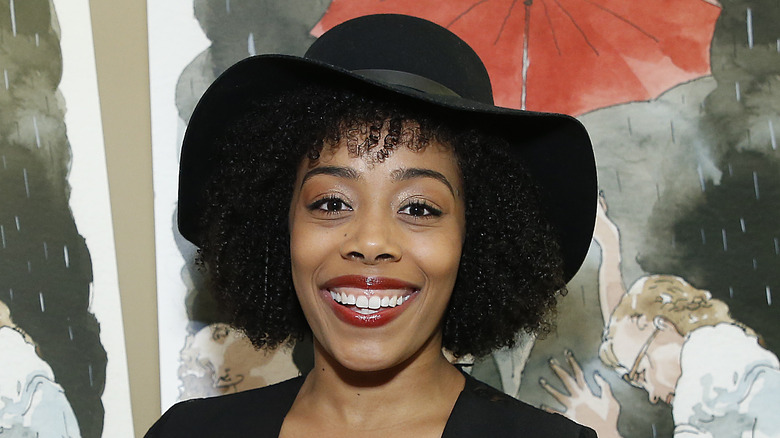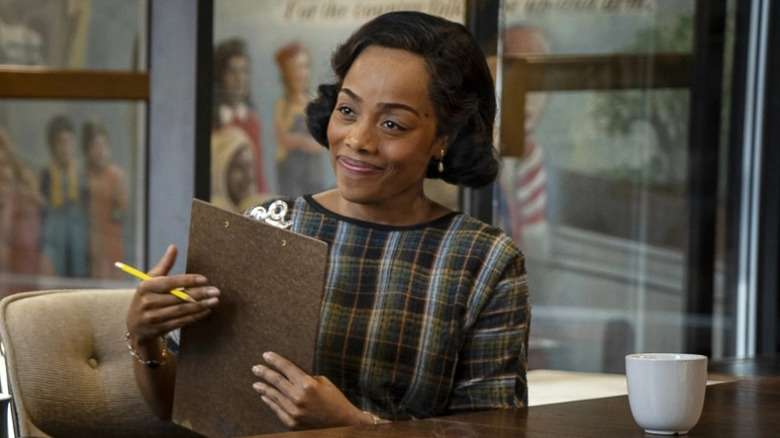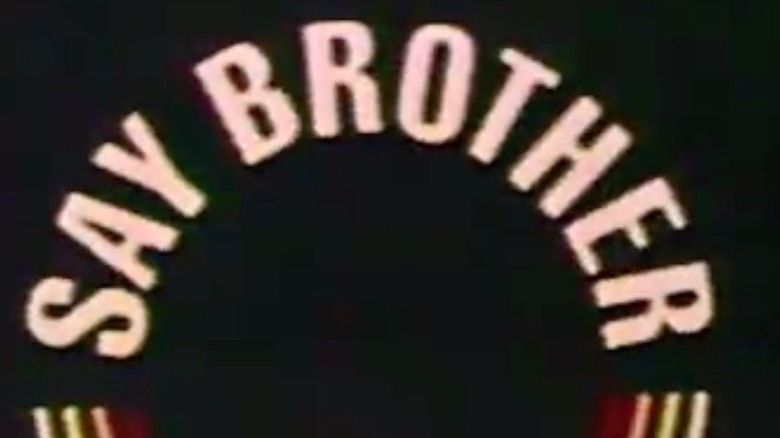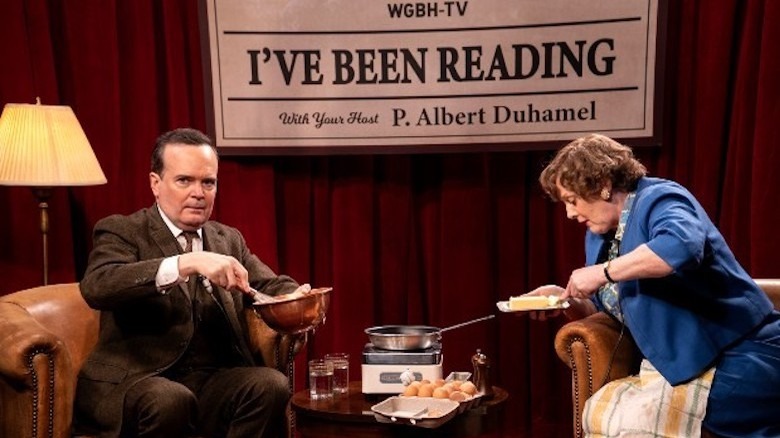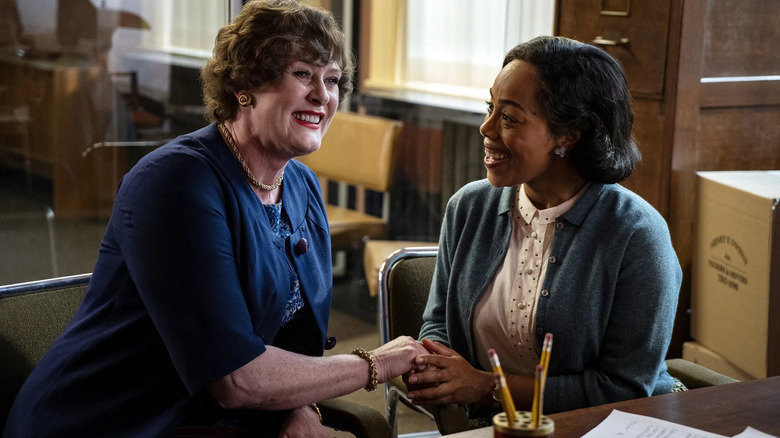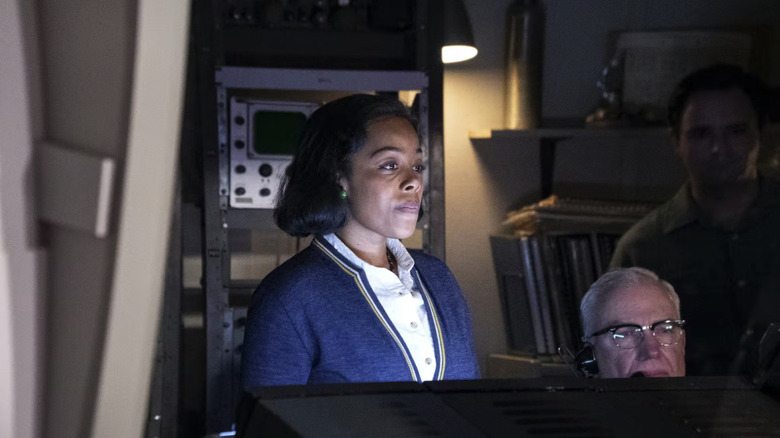The Untold Truth Of Alice Naman
There's no doubt that HBO's show "Julia" has been a smash hit: The show currently only has one season out of the oven, and already, it has attained a 93% audience satisfaction score on Rotten Tomatoes.
"Julia" is set in Boston in the early 1960s. It follows the struggles of chef Julia Child (perfectly portrayed by Sarah Lancaster) as she brings her show, "The French Chef," to the air at a time when TV was fairly new, and girlbosses were few and far between.
The show depicts Child's feminism, her relationship with her husband Paul (played by David Hyde Pierce), and the creation of her cultural legacy. "Julia" also offers generous arcs for the supporting characters, including Julia's best friend Avis DeVoto (Bebe Neuwirth) and producer Russ Morash (Fran Kranz). But the key character who has everyone talking is Alice Naman, played by Brittany Bradford.
"Julia" offers a semi-fictionalized version of events, and many people have wondered if Alice Naman was a real person in Julia's life. Not so long ago, we simply wouldn't have seen a character like Alice Naman in a period piece like "Julia": Naman is a young, middle-class Black woman working in television in 1962; a time when the Civil Rights Act of 1964 was still a couple of years away.
Alice is a pioneer just like Julia, and the parallels and differences between their journeys add a modern depth to the story. There's so much to know about the character of Alice Naman.
Alice Naman is based on real-life women producers
Alice Naman is a composite character based on a number of female producers working in television in the 1960s. Julia Child's "The French Chef" was filmed at the WGBH studios in Boston, and it had two women producers among its staff: Assistant producer Miffy Goodhart (per Parade) and producer Ruth Lockwood (per IMDB); however, both women were white.
As Brittany Bradford (who plays Alice) explained to Vulture, the first thing she asked the "Julia" showrunners was the reasoning behind making Alice a Black character. "I didn't want to be tokenized or there just because they wanted to have a Black character," she said.
But executive producer Chris Keyser had an intriguing story in response. "He talked about family friends he had growing up, an interracial couple–a Black woman and a white man–who met at WGBH as producers," Bradford said. "He told me people don't know her story and wouldn't even think she would have been working around the time."
Alice is an important character: She believes in the potential of Julia Child's show before her male superiors, and she invigorates the industry by working independently to syndicate the show to other stations, ensuring that "The French Chef" has the financing it needs to continue.
Ultimately, the key element isn't whether a Black woman like Alice was there. Rather, it's the possibility that she could have been there: Alice's story, like the story of other pioneers like her, has never been told before.
The character was also inspired by Black TV producers from the 1960s
Although "Julia" is set in the 1960s, it's airing in 2022, when the conversations surrounding race and representation are very different. Executive producer Chris Keyser and creator Daniel Goldfarb's research into WGBH found that there were young Black employees working at the TV station in the early 1960s (via The Washington Post).
Indeed, in 1968 the station premiered a show "by, for, and about African Americans" called "Say Brother" (per the American Archive of Public Broadcasting). It ran until 1997 when it was re-named "Basic Black" (1998-present). The show featured programs and interviews with many Black cultural icons, including Maya Angelou, Hubie Jones, and Stokely Carmichael.
One early woman producer of "Say Brother," Carol Munday Lawrence (per IMDB), went on to become the first Black woman to write and produce a nationally broadcasted television series with her 1981 series "Were You There?" (via to South Side Projections).
Madeline Anderson was another trailblazer. She was known as the first woman to produce and direct both a syndicated TV series and a televised documentary, the first Black employee at WNET public television in New York, and one of the first Black women members of the film editor's union. She later became a producer and director for "Sesame Street" (according to the National Museum of African-American History and Culture).
Stories like Anderson and Munday Lawrence's provide historical context for Alice Naman's fictional character and career.
Julia Child's female producers helped make her show a success
Alice Naman is instrumental in bringing the show to the small screen in "Julia. Similarly, Julia Child's real-life producers, Miffy Goodhart and Ruth Lockwood, were an enormous part of the success of "The French Chef."
According to "Dearie, the remarkable life of Julia Child" by Bob Spitz (excerpted in Parade), assistant producer Goodhart booked Julia Child in her first television appearance on a literary show called "People Are Reading" to promote her cookbook, "Mastering the Art of French Cooking."
In one of the first-ever live cooking demonstrations on television, Julia whipped up an omelet for the startled host (hilariously re-enacted in the first episode of "Julia"), and a new TV star was born.
However, the first season of "The French Chef" would not have been made without Goodhart's dogged determination: Once she had ascertained the audience's enthusiastic response to Julia's personality, she worked to convince Russ Morash, the future director of "The French Chef," as well as the program manager and station manager regarding the show until they agreed to invite Julia back.
Producer Ruth Lockwood was also instrumental to the success of "The French Chef": She found the show's iconic theme tune, and she also helped Julia make TV history by convincing the Johnson administration to broadcast the White House state dinner in 1968 (detailed in Alex Prud'homme's "The French Chef in America") in a program titled "White House Red Carpet with Julia Child" (per the American Archive of Public Broadcasting).
Alice Naman's character addresses some important themes
The 1960s kicked off broader conversations about the women's equality movement. Hence, some of the main themes of "Julia" are feminism and the empowerment of women (via The Washington Post). The character of Alice Naman also broadens those themes by introducing a very necessary intersectionality.
One of the most striking (albeit fictionalized) moments in the show arises when Betty Friedan, author of "The Feminist Mystique," meets Julia Child, and they converse regarding whether Julia's cooking show is beneficial for the cause of women's rights.
There is no doubt that Julia Child was a pioneer on television and in American culture. Child's appearance serves as a reminder that a woman can be big and brash and still be beloved. But as both The Washington Post and "Julia" point out, Julia came from money, so her confidence is partly a product of her education and her privilege.
In some ways, Alice Naman's character works as a parallel to Julia's. She is undoubtedly a pioneer in her own right, but the structural misogyny and racism of the world affect her differently than Julia.
At times, the show seems to gloss over what might otherwise be opportunities for depicting period-typical racism, except for one memorable scene in a butcher's shop where Alice is overlooked and not offered service. But mostly, Alice and Julia's parallel stories provide a nuanced portrait of the meaning of feminism for different identities, one that is all too relevant today.
Alice's arc over the season does justice to her character
Part of the process of bringing a character like Alice Naman to life is ensuring that her character is more than just a representation of pioneering female television producers of color (via Vulture). Over the first season of "Julia," Alice has an arc and supporting characters that give her character real depth.
From the ongoing efforts of her match-making mother, Virginia, to the hints at her middle-class background (both her brothers are doctors), to the fact that Alice can't cook at all before she meets Julia (a nice subversion of typical stereotypes surrounding Black women), Alice feels like a real person, which is why so many "Julia" fans have simply assumed she was a real WGBH employee.
Even her romantic arc, which could have lacked nuance, introduces a character whose primary goal is to support her in her ambitions, something she finds lacking from both her white male bosses at the studio and, at times, even from Julia herself.
As Brittany Bradford noted in Vulture, over the course of the first season, Alice blossoms into a more self-assured, confident woman with a clearer idea of her own capabilities and her specific vision for her career. She faces the impossibly immovable obstacles of racism and misogyny, and although she cannot defeat them, she is not defeated by them.
